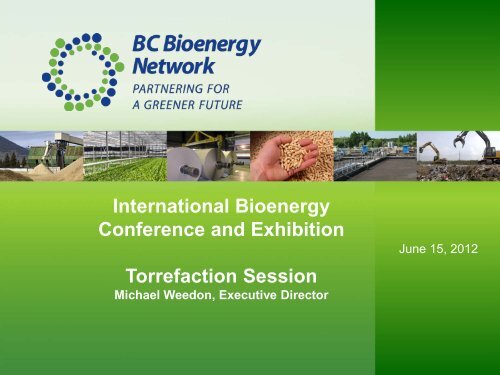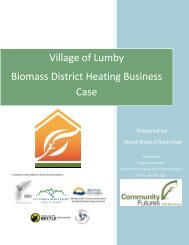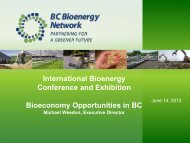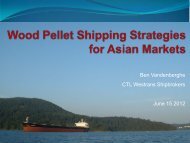Michael Weedon: Torrefaction Session - International Bioenergy ...
Michael Weedon: Torrefaction Session - International Bioenergy ...
Michael Weedon: Torrefaction Session - International Bioenergy ...
Create successful ePaper yourself
Turn your PDF publications into a flip-book with our unique Google optimized e-Paper software.
<strong>International</strong> <strong>Bioenergy</strong><br />
Conference and Exhibition<br />
<strong>Torrefaction</strong> <strong>Session</strong><br />
<strong>Michael</strong> <strong>Weedon</strong>, Executive Director<br />
June 15, 2012
<strong>Torrefaction</strong> Technical <strong>Session</strong> Thought Starters<br />
What the financial community is saying about<br />
biomass and torrefaction<br />
‣ CIBC World Markets<br />
‣ Bloomberg New Energy Finance through<br />
Pacific Carbon Trust<br />
2
CIBC World Markets, Don Roberts, Vice<br />
Chairman, (with permission)<br />
Following are five slides recently presented from<br />
his presentation NSERC Bioconversion<br />
Network Pretreatment Workshop UBC,<br />
Vancouver, Canada, June, 2012<br />
3
Global Biomass Investment Trends<br />
<br />
<br />
<br />
<br />
<br />
<br />
Global investments in energy plants using biomass (i.e., solids)have hovered around $9-10 B/year since<br />
2007 – much more consistent than for biofuels (ie., liquids).<br />
Europe is the leader, followed by China.<br />
China’s NDRC is targeting to increase biomass power from
Europe & Asia are the Centres for Biomass Demand<br />
Global Biomass Shipping Routes<br />
Note: Dotted cycles represent the major demand centres; the strength of the arrows is relative to their importance as trading routes.<br />
Source: Bloomberg New Energy Finance, IEA, CIBC World Markets<br />
Europe is the biggest demand region, but Asia is growing<br />
quickly.<br />
In 2011, wood pellet capacity in the U.S. exceeded that in<br />
Canada<br />
| 5
Biomass demand for co-firing in Europe is expected grow to approach 14 million tpy by<br />
2014 – a 40% increase over 2010. Three biggest demanders are Drax, RWE and GDF Suez.<br />
Biomass Demand For Co-Firing by Parent Company 2011 (million ODMT)<br />
European Demand for Bio-Energy<br />
Note: using installed capacity rates in the UK, Netherlands, Poland and Denmark – this graph accounts for 83% of installed capacity. “Other” biomass includes<br />
palm kernel shells, energy crops and other biomass sources.<br />
Source :Company reports, Bloomberg New Energy Finance, CIBC World Markets<br />
| 6
LEVELISED COST OF ELECTRICITY Q1 2012<br />
($/MWH)<br />
• Wide range of costs, depending on local<br />
conditions & scale.<br />
• With currently commercial technologies,<br />
bio-electricity is generally in the bottom<br />
half of the cost curve, but its relative<br />
cost position will likely deteriorate going<br />
forward<br />
• Biomass is different than most<br />
renewable sources of energy - provides<br />
base load power, and optionality.<br />
Note: Carbon forecasts from the Bloomberg New Energy Finance European Carbon Model with an average<br />
price to 2020 of $33/mtCO2. Coal and natural gas prices from the US Department of Energy EIA Annual<br />
Energy Outlook 2011 and internal forecasts. Percentage change represents change from Q4 2011.<br />
Source: Bloomberg New Energy Finance, CIBC World Markets Inc.
Torrefied vs Conventional Wood Pellets<br />
If you want to invest in solid biofuels, best to go opt for torrefied as opposed to conventional<br />
pellets. It results In Significantly Lower Costs In The Entire Value Chain ~20% less.<br />
Cost Comparison Based On The Same Physical Value Chain USD/GJ<br />
12<br />
11.07 $/GJ 9.30 $/GJ<br />
Savings<br />
Logistics<br />
10<br />
4.16<br />
2.55<br />
Financial cost<br />
8<br />
1.01<br />
Process cost<br />
Cost of Biomass<br />
6<br />
4<br />
0.70<br />
1.77<br />
2.28<br />
3.45<br />
O&M cost<br />
Investment cost<br />
3.71 $/GJ<br />
0.53 0.53<br />
point<br />
2<br />
4.44<br />
1.4<br />
1.4<br />
1.78<br />
1.78<br />
0<br />
Landed costs of Wood<br />
Pellet<br />
Landed costs of Torrefied<br />
Pellet<br />
Savings landed costs Avoided cost at utility Total saving<br />
Assumption: Both plants are located in the south eastern region of the United States, are<br />
located 100 km from a deep sea port, and the pellets are shipped to Rotterdam.<br />
* Feedstock cost includes: delivered chipped cost of whole logs for wood pellet; whole logs and logging residues for torrefied pellet assuming 50% moisture<br />
content<br />
** Process cost includes: electricity, labour, SG&A, binding agent, royalty and other operating costs<br />
*** Financial cost includes: depreciation, interest on debt<br />
**** Logistics includes: the cost of transportation and handling from plant to power plant<br />
| 8
BC <strong>Bioenergy</strong> in collaboration with Pacific<br />
Carbon Trust reports from Bloomberg New<br />
Energy Finance<br />
<strong>Torrefaction</strong> – a technology that turns wood into a fuel<br />
similar to coal – is tipped to become the next big<br />
development in the biomass industry. But can it<br />
overcome the technological and economic barriers to<br />
commercialization? This Research Note proposes cost<br />
estimates and a roadmap for the industry.<br />
9
As reported from Bloomberg New Energy<br />
Finance<br />
Torrefied pellets could enable power plants to co-fire large<br />
amounts of biomass – using a variety of feedstocks –<br />
with little reduction in output efficiency, limited changes<br />
to the plant and reduced transportation and storage<br />
costs.<br />
10
As reported from Bloomberg New Energy<br />
Finance<br />
Once torrefaction industry reaches commercial scale, it<br />
should grow considerably, and potentially overtake<br />
today’s wood pellet industry. It should also open up<br />
routes for Australia, southern Africa and South America<br />
to start shipping biomass cheaply to Europe.<br />
11
As reported from Bloomberg New Energy<br />
Finance<br />
In 2015, we project it will cost $128 per tonne (or $5.82 per<br />
GJ) to deliver torrefied pellets when excluding<br />
feedstock costs to a hypothetical European coal plant,<br />
with transport and capital costs being the largest items.<br />
This compares with a current wood pellet delivery cost<br />
of $123 per tonne (or $6.81 per GJ). Torrefied pellets<br />
will provide conversion and transportation costs<br />
savings relative to wood pellets.<br />
12
Thank you<br />
<strong>Michael</strong> <strong>Weedon</strong><br />
BC <strong>Bioenergy</strong> Network<br />
www.bcbioenergy.ca<br />
13










